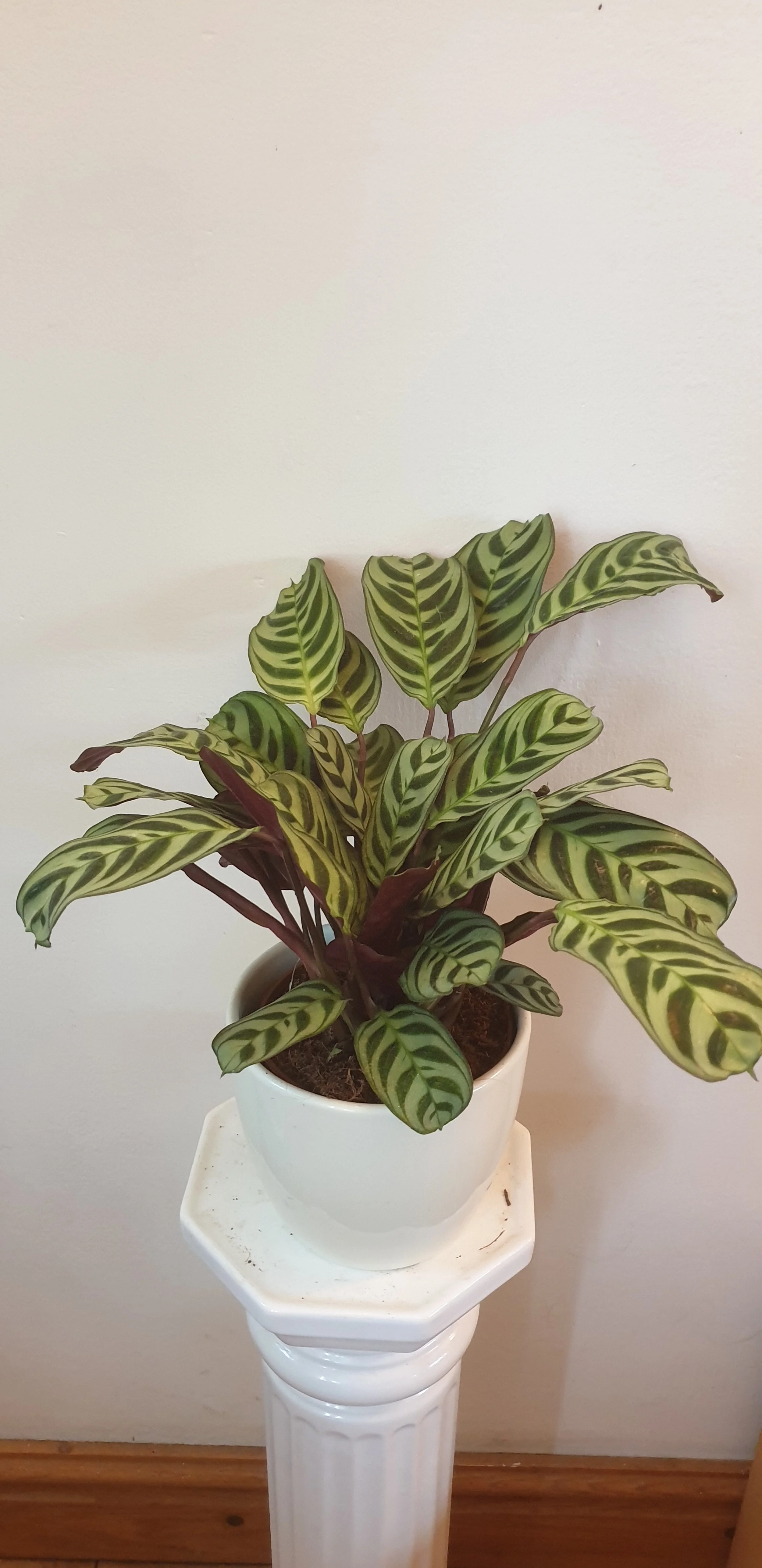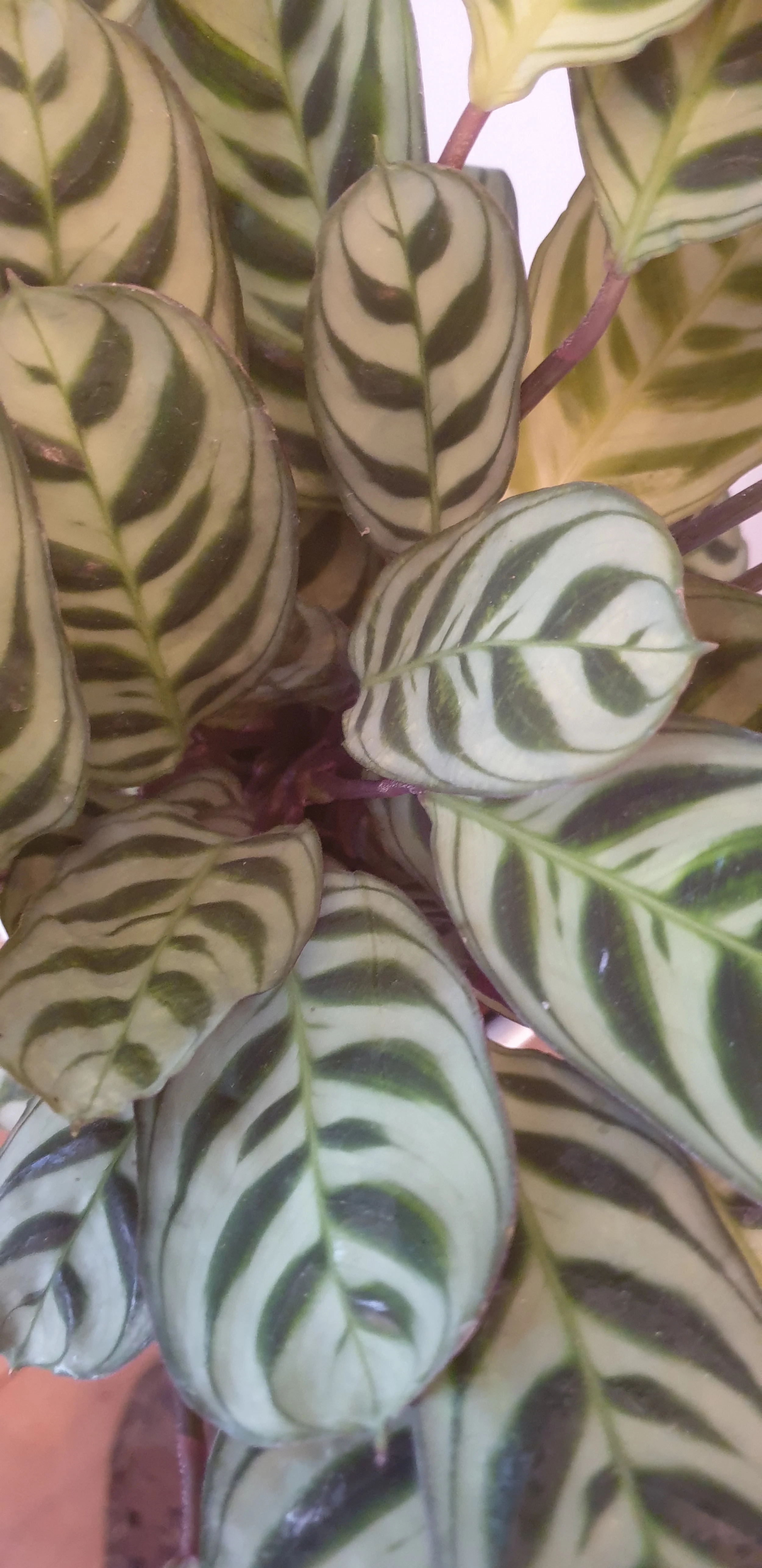 Image 1 of 2
Image 1 of 2

 Image 2 of 2
Image 2 of 2



Ctenanthe Burley Marx in 12 cm pot.
Ctenanthe burle-marxii is a stunning, low-growing tropical plant named after Brazilian landscape architect Roberto Burle Marx. It’s part of the Marantaceae (Prayer Plant) family and shares the characteristic rhythmic leaf movement — folding up at night and opening in the morning.
✅ Key Features:
Foliage: Elongated, oval leaves with a silvery-green base and striking dark green herringbone (fishbone) patterns.
Undersides: Rich purple to burgundy, adding a vibrant contrast.
Growth Habit: Creeping and spreading, often forming a lush ground cover in nature. It looks beautiful in low planters or hanging pots.
Movement: Exhibits nyctinasty, meaning the leaves fold upward at night and relax during the day.
---
🪴 Ctenanthe 'Burle-Marxii' Care Guide
This plant thrives with care similar to other members of the Marantaceae family but is often a bit more resilient than Marantas.
☀️ Light
Prefers bright, indirect light.
Will tolerate lower light but may grow more slowly and lose some vibrancy.
Avoid direct sun—it can scorch the delicate leaves.
💧 Watering
Keep soil consistently moist, but not soggy.
Allow the top 1–2 inches of soil to dry before watering again.
Use filtered or distilled water if possible to avoid leaf browning due to chemicals in tap water.
🌡️ Temperature & Humidity
Temperature: 65–80°F (18–27°C)
Humidity: Thrives in high humidity (50–60%+).
Use a humidifier or mist regularly.
Can suffer in dry air (leaf curling or browning tips).
🌱 Soil
Use a light, well-draining mix that retains some moisture.
Mix: 2 parts peat or coco coir, 1 part perlite, 1 part orchid bark or sand.
🌸 Fertilizer
Feed every 4–6 weeks during spring and summer with a balanced, water-soluble fertilizer (diluted to half strength).
Avoid over-fertilizing — it can lead to root burn.
🪴 Repotting
Repot every 1–2 years or when roots begin to outgrow the pot.
Spring is the ideal time for repotting.
✂️ Pruning & Maintenance
Trim dead or damaged leaves to encourage new growth.
Pinch back leggy stems to maintain a full, bushy appearance.
🌱 Propagation
Propagated by division during repotting. Gently separate root clumps and replant.
🐛 Common Problems
Leaf curl/droop: Usually from underwatering or low humidity.
Brown edges/tips: Typically from dry air or hard water.
Pests: Look out for spider mites, mealybugs, and scale. Treat with neem oil or insecticidal soap.
---
🐾 Pet Friendly?
✅ Yes! Ctenanthe burle-marxii is non-toxic to cats and dogs.
---
🧘♀️ Bonus Tip:
Place it in a bathroom with a bright window — the natural humidity and indirect light are perfect for this tropical plant.
---
Would you like a care card, printable infographic, or a comparison guide between Ctenanthe, Maranta, and Calathea next?
Ctenanthe burle-marxii is a stunning, low-growing tropical plant named after Brazilian landscape architect Roberto Burle Marx. It’s part of the Marantaceae (Prayer Plant) family and shares the characteristic rhythmic leaf movement — folding up at night and opening in the morning.
✅ Key Features:
Foliage: Elongated, oval leaves with a silvery-green base and striking dark green herringbone (fishbone) patterns.
Undersides: Rich purple to burgundy, adding a vibrant contrast.
Growth Habit: Creeping and spreading, often forming a lush ground cover in nature. It looks beautiful in low planters or hanging pots.
Movement: Exhibits nyctinasty, meaning the leaves fold upward at night and relax during the day.
---
🪴 Ctenanthe 'Burle-Marxii' Care Guide
This plant thrives with care similar to other members of the Marantaceae family but is often a bit more resilient than Marantas.
☀️ Light
Prefers bright, indirect light.
Will tolerate lower light but may grow more slowly and lose some vibrancy.
Avoid direct sun—it can scorch the delicate leaves.
💧 Watering
Keep soil consistently moist, but not soggy.
Allow the top 1–2 inches of soil to dry before watering again.
Use filtered or distilled water if possible to avoid leaf browning due to chemicals in tap water.
🌡️ Temperature & Humidity
Temperature: 65–80°F (18–27°C)
Humidity: Thrives in high humidity (50–60%+).
Use a humidifier or mist regularly.
Can suffer in dry air (leaf curling or browning tips).
🌱 Soil
Use a light, well-draining mix that retains some moisture.
Mix: 2 parts peat or coco coir, 1 part perlite, 1 part orchid bark or sand.
🌸 Fertilizer
Feed every 4–6 weeks during spring and summer with a balanced, water-soluble fertilizer (diluted to half strength).
Avoid over-fertilizing — it can lead to root burn.
🪴 Repotting
Repot every 1–2 years or when roots begin to outgrow the pot.
Spring is the ideal time for repotting.
✂️ Pruning & Maintenance
Trim dead or damaged leaves to encourage new growth.
Pinch back leggy stems to maintain a full, bushy appearance.
🌱 Propagation
Propagated by division during repotting. Gently separate root clumps and replant.
🐛 Common Problems
Leaf curl/droop: Usually from underwatering or low humidity.
Brown edges/tips: Typically from dry air or hard water.
Pests: Look out for spider mites, mealybugs, and scale. Treat with neem oil or insecticidal soap.
---
🐾 Pet Friendly?
✅ Yes! Ctenanthe burle-marxii is non-toxic to cats and dogs.
---
🧘♀️ Bonus Tip:
Place it in a bathroom with a bright window — the natural humidity and indirect light are perfect for this tropical plant.
---
Would you like a care card, printable infographic, or a comparison guide between Ctenanthe, Maranta, and Calathea next?